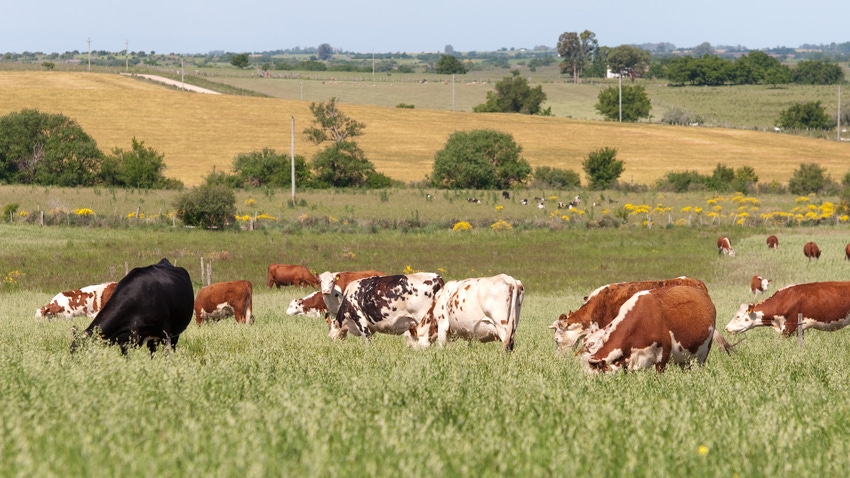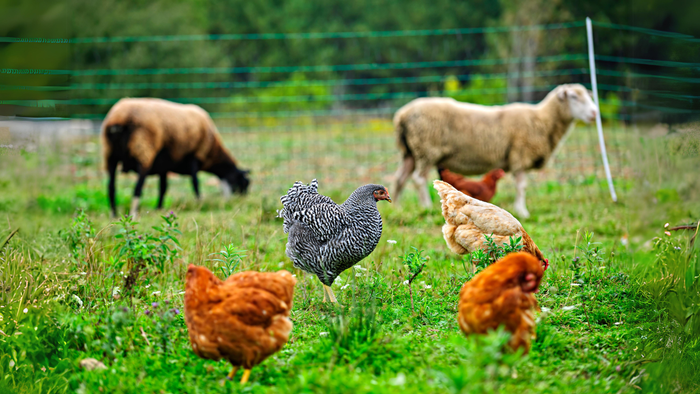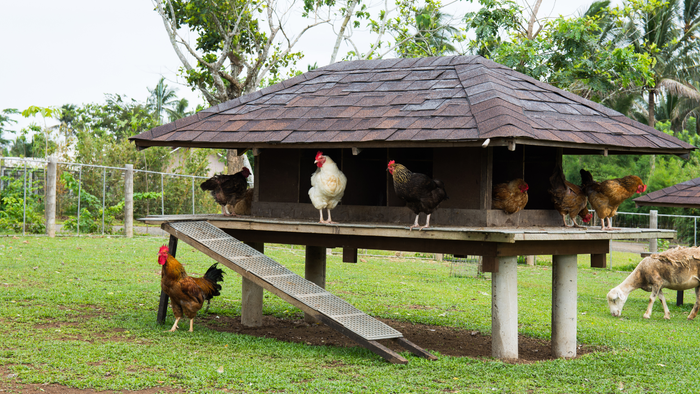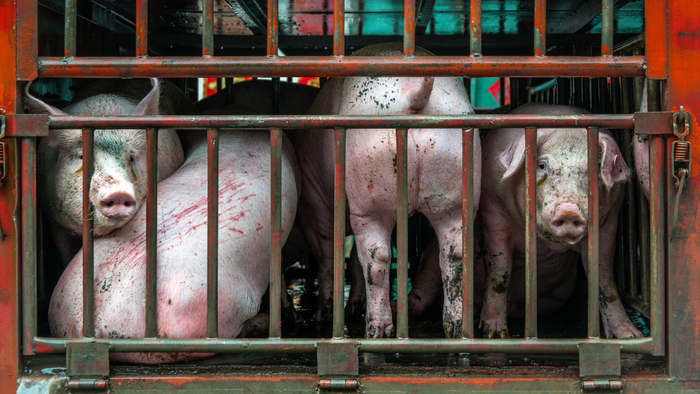10 new USDA rules on raising organic livestock and poultry
Organic livestock and poultry producers must ensure animals’ lifelong health and wellbeing beginning next year. Learn more about these new standards.
February 13, 2024

A new year means new rules and regulations. How animals are treated for organic food makes a big difference. Organic producers and ranchers now have more to consider than ever.
After years of discussion and a lawsuit by the Organic Trade Association, the U.S. Department of Agriculture’s new Organic Livestock and Poultry Standards became effective on Jan. 12. The OTA and other organizations pushed for the changes to improve animal welfare and encourage more consistent livestock production practices.
The rule clarifies how organic producers and handlers must treat livestock and poultry to ensure their health and wellbeing throughout life, including transport and slaughter, establishes minimum indoor and outdoor space requirements and what is allowed and prohibited in organic livestock and poultry production.
“Organic food is one of the ways we change the world. And one of the ways we offer consumers the opportunity to make a choice about good food,” says Adam Warthesen, the director of government and industry affairs at Organic Valley, an organic food brand and independent cooperative of 1,600 organic family farms in 32 states. “Organic regulations cannot be static. They have to be able to change and evolve to make sure companies and producers are all operating from the same playing field.”
With some exceptions, organic operators must comply with the requirements of the rule by Jan. 2, 2025. Most operations have to comply with the rule’s indoor requirements by that date but have until January 2029 to comply with outdoor spacing and exit requirements.
“The new rule brings comprehensive clarity to animal welfare in all forms of livestock,” says Tom Chapman, CEO of Organic Trade Association. “It definitively makes it clear that animal welfare is integrated within the organic standards.”
Originally, the new rule would have gone into effect on Jan. 2, 2024.
The USDA’s Agricultural Marketing Service (AMS) delayed the effective date of the ruling until Jan. 12 so it could meet the requirements of the Congressional Review Act, which requires federal agencies to provide Congress at least 60 days to review a major rule before it takes effect. Originally, the USDA published its final rule on Nov. 2 and then notified Congress on Nov. 13, which would have violated the act.
“Somehow they stopped notifying Congress, so several rules had to repost their effective dates,” Champman says.
As a result, the new rule won’t be implemented until 2025.

New USDA rules bring greater consistency to applying organic standards.
A long, laborious push for change
Over the past few decades, the National Organic Standards have rarely been updated, Chapman says. The first recommendations to National Organic Standards Board about animal welfare, clean healthcare practices and outdoor access came more than two decades ago.
“We’re treating this as a 21-year fight,” Chapman says.
In April 2016, the USDA proposed new Organic Livestock and Poultry Practices (OLPP) to bring greater "consistency and transparency" to USDA organic standards.
On Jan. 19, 2017—the day before President Barack Obama left office—the USDA, under the guidance of U.S. Agriculture Secretary Tom Vilsack, published a final rule, amending the National Organic Program’s regulations for organic livestock and poultry practices for living conditions, animal health care, transport and slaughter.
“Before that effective date, the Trump administration halted all rulemaking and clawed back all these rules,” Warthesen says.
The Organic Trade Association sued the U.S. Department of Agriculture in September 2017 on the grounds it violated the Organic Foods Production Act and unlawfully delayed the effective date of the final livestock standards that industry developed in accordance with the congressionally established processes.
The OTA alleged the USDA violated the Administrative Procedure Act, which governs the process which federal agencies develop and issue regulations, because it repeatedly delayed enacting the rule without any public process and abused its ability to indefinitely delay or kill the rule.
“The rationale provided for why [the USDA] withdrew that rule was flawed,” Warthesen says. The USDA said animal raising practices were outside the scope of the national guidance program can do, “which is crazy,” he added.
“The department has always had the ability to enhance animal raising practice standards,” he says.
When the Biden administration took office, Tom Vilsack returned as the U.S. Agriculture Secretary.
“This administration said they would back into rulemaking,” Chapman said, which paved the way for current changes in organic animal welfare practices.
The rule focuses on more consistent standards in six areas: Outdoor space requirements, indoor and outdoor living conditions, stocking densities, preventative health care practices, physical alterations and the ability to use humane euthanasia, and the transportation, handling and slaughter of livestock and poultry.
“This organic poultry and livestock standard establishes clear and strong standards that will increase the consistency of animal welfare practices in organic production and in how these practices are enforced," U.S. Agriculture Secretary Tom Vilsack said in a released statement. "Competitive markets help deliver greater value to all producers, regardless of size."

Closing organic certification loopholes
With tighter restrictions in place, many organic poultry and livestock producers, farmers and ranchers have more to consider.
“The center point of the rule is ‘How do you care for animals in organic systems?’” Warthesen says.
The ruling closes a lot of loopholes within organic certifications, including what constitutes outdoor, shade, shelter, exercise areas and access to fresh air, clean water for drinking and direct sunlight. Also included are stocking densities—the number of animals allowed per unit area.
Warthesen says the new rule creates a more cohesive playing field among organic producers.
“The challenge has been one set of certifiers says outdoor access just means a bird can sit on a perch outside of the barn that’s netted in,” Warthesen says. “And another set of farmers are saying outside access means the chickens are actually going outside, they’re going to touch the ground and act like chickens.”
Farmers that hold a more expansive understanding of what it means to be outside are at a competitive disadvantage, then because more space costs more money and it’s more expensive to maintain, he says.
The Organic Trade Association argues that many regulations have not been consistently enforced, resulting in a few large poultry companies utilizing narrow, enclosed porches, many times with a cement floor instead of true outdoor access.
“Animal welfare was always in the standards, the problem was the requirement wasn’t very clear,” Chapman says. “There wasn’t enough comprehensive detail for certifiers to make the same decision consistently. A couple of larger operations exploited that vagueness in the rulemaking to not allow for proper access, not provide appropriate animal welfare or comply with stocking rates.”
1 - Defining outdoor space
The new law revises the definition of “pasture pens.” Birds now must be allowed to express their natural behaviors. Poultry must have direct access to soil and be allowed to dust bathe and scratch. That means outdoor enclosures can’t have solid walls or roofs. But they can have fencing and netting to keep out predators and wild birds.
Ground in the enclosures have to be at least 50% soil so chickens can dust bathe. This allows chickens to clean their feathers and prevent them from becoming too oily, which can also reduce illness.
“If your chickens never get away from the feed, they are just eating all the time and creating lots of eggs,” Warthesen says. “Versus, if they are allowed to be chickens, scratching around in the dirt, living their best life, they are producing beautiful eggs, too.”
2 - Preventive healthcare
Organic livestock operations need to minimize internal parasite problems with better healthcare. A plan “must include preventive measures such as pasture management, fecal monitoring and emergency measures in the event of a parasite outbreak.”
Organic operators need to identify and record the treatment of sick and injured animals. They also must provide treatment and preventative healthcare.
3 - Ban on physical alterations as routine procedures
The Organic Livestock and Poultry Standards (OLPS) Final Rule prohibits certain physical alterations including debeaking, induced molting—reducing feedstock to increase production-—and needle teeth clipping, de-snooding and tail docking as routine procedures. The law allows them only ‘‘with documentation that alternative methods to prevent harm failed.’’
Also included is the ban of caponization, a surgical technique to alter the sex of a male bird through castration or estrogen implants and dubbing, the removal of the comb, wattles and sometimes removal of poultry’s earlobes.
Surgical procedures on livestock to treat illness or injury must be done in a manner that minimizes pain, stress, and suffering.
4 - Improved living conditions
Organic livestock now need to be split by species. Shelter space must be large enough for animals to lie down, stand up, fully stretch their limbs and exhibit normal behavior patterns. Bedding and resting areas need to be sufficiently large and comfortable enough to keep animals clean, healthy and dry. Stalls must be used, and a cage doesn’t qualify as a stall.
5 - Flat decks and piglet cages banned
For swine housing, pigs must be kept in group housing, always having access to rooting materials. Two new provisions included in the ban are the use of flat decks or piglet cages.
6 - Measuring and limiting ammonia
When chickens poop, their manure creates a lot of nitrogen that produces ammonia as it decomposes. Ammonia levels need to be monitored and can’t exceed 25 parts per million. “It’s got to be maintained and you’ve got to check it every week,” Warthesen says.
7 - Freedom to move
The rule also prohibits the use of gestation or farrowing crates for sows at farrowing and suckling period. Animals have to have a degree of freedom of movement, Warthesen says.
Organic poultry are banned from continuous total confinement and must have year-round outdoor access. Poultry housing must allow all birds to move freely, stretch both wings simultaneously, stand normally and engage in natural behaviors.
To ensure all birds have easy outdoor access, poultry houses must have at least 1 linear foot of exit area for every 360 birds.
8 - Better use of artificial light
For “layers” and other full-feathered birds, artificial light used to prolong the day must be lowered gradually to encourage hens to move to perches or settle for the night. It also can’t be used to manipulated to increase feed intake and growth rate.
9 - Keep out wildlife
Organic producers must take steps to prevent stray poultry, wild birds, cats and other animals from entering poultry houses.
10 - Transportation and slaughter
The new rule contains many new standards on the humane treatment, transportation and slaughter of organic livestock and poultry.
Animals must be fit for transport and able to walk. The rule prohibits the transport of “seriously crippled” in addition to “non-ambulatory” animals transported for sale or slaughter. Seasonally appropriate ventilation must be used to protect against cold or heat stress. Clean, dry bedding has to be used appropriately, as well.
Also included is the handling and slaughter of poultry that were previously exempt or not covered by inspection requirements of Poultry Products Inspection Act (PPIA). The hanging, carrying or shackling of lame birds by their legs is banned to prevent needless suffering.
There’s also an eight-hour threshold. Livestock operators must describe how they will maintain organic management and welfare if transport time exceeds eight hours. This is measured from the time all animals are loaded onto a vehicle until it arrives at its final destination.

The new USDA rules require humane treatment, transportation and slaughter of organic livestock and poultry.
Better late than never
“It should have been done years before the original proposed rule was in place,” Warthesen says. “The heartburn there is that it took too long.”
That’s unfortunate, he says, because it’s created a lot of competitive harm, causing many organic farmers to suffer and go out of business trying to compete against others who were using organic labeling but exploiting loopholes in the previous law.
“We have a federal standard on what it means to be organic,” Warthesen says. “And that’s really precious. There’s nothing else like that, that I’m aware of, and that means constant vigilance.”
Read more about:
OrganicYou May Also Like


